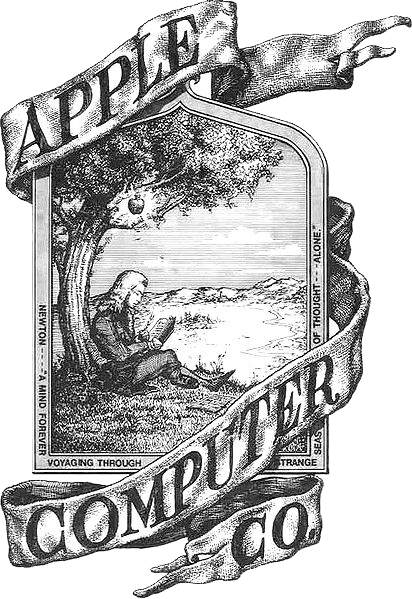 |
| The original Apple Computer logo |
To dismiss a couple of unlikely ones, I very much doubt that the original Archimedes jumping out of the bath story has any validity. And there's good evidence that Galileo didn't get a sudden understanding of gravitational pull while dropping balls of different weights off the leaning tower of Pisa. (The evidence for this is that Galileo never mentions it. It is only told by an assistant who was writing about Galileo near the great man's death. But Galileo was a superb self-publicist. If he had done it, he would have bragged about it.)
However I'd also like put forward a classic that I feel probably is true. Newton and the apple. I'm not saying that an apple hit him on the head - that is pure fiction - but I don't think it's at all unreasonable that seeing an apple fall sparked a chain of thought. Here's Newton's own words on the subject, related by the historian William Stukeley:
After dinner, the weather being warm, we went into the garden, and drank thea [sic] under the shade of some apple trees; only he and myself. Amidst other discourse, he told me, he was just in the same situation, as when formerly, the notion of gravitation came into his mind. Why should that apple always descend perpendicularly to the ground, thought he to himself; occasion’d by the fall of an apple, as he sat in a contemplative mood.The fact is that there is strong evidence that humans tend to come up with their best ideas when they are not sitting at their desk trying to work, but rather when they are only half conscious of what they are dealing with. Perhaps on a walk (I get most of my ideas walking the dog), driving, or in Newton's case, sitting relaxing. It feels right. So hands off, historians of science. Even if it wasn't true, this kind of story is useful as myth - but in this case there is every possibility that it was.
Image from Wikipedia

Possibly Newton's words about how the notion of gravitation came to him were somewhat disingenuous. After all, Robert Hooke had been making somewhat similar points some twenty years earlier. And Newton himself acknowledged the earlier work of Bullialdus and Borelli.
ReplyDeleteNewton and the apples is a nice story. He wasn't a bad self-publicist either, it would seem.
Watch this space for a post on Hooke, coincidentally, on Friday. Hooke had made some observations that were new to Newton (one of which Newton acknowledged getting from him), but didn't come close to the full works.
ReplyDeleteI'm not suggesting anyone isn't influenced by others - shoulders of giants and all that - but that the apple event probably did happen as a point where it all came together.
Newton wasn't a great self-publicist, he was rubbish at publishing. It was usually someone else who pushed it through or publicized it, in this case Stukeley.